Winter Solstice - Tahiti
Papeete - June 22, 2008
We arrived in Papeete, Tahiti, the capital of French Polynesia, on Thursday morning. Two very squally days at sea from Toau atoll left us off the main pass through the barrier reef into Papeete about an hour before dawn. We hove to waiting for daylight, and it began to rain once more. We waited for two hours for the downpour to end, and at 8 AM we motored through the reef into Papeete Harbor and then we continued inside the reef past the main airport to the small boat anchorage outside the Tahina Marina. After securing the boat there was finally time to sleep.
Last night Tahiti celebrated the winter solstice, the shortest day of the year down here. There were festivals and singing all over the island and we decided to observe them in the big city. We bussed downtown on "Le Truck," one of a few remaining small busses originally constructed out of old flatbed trucks. We sat in a passenger compartment fashioned locally out of wood and bolted to the truck bed. Le Truck is small, there is no standing headroom, and when it is full or nearly so one must climb over fellow passengers to enter and to exit. The tariff is 130 Overseas Francs, about two U.S. dollars, as announced in hand lettering on a panel behind the driver, and it is collected by a driver's helper who makes change and keeps no fare box. The route conveniently runs right by the marina to the downtown waterfront. The windows are always open and the engines are loud and belch diesel smoke, and it is hard not to bump your head or bruise your thighs entering and exiting, but Le Truck is patronized by locals of all ages - riding it presents a colorful slice of real life in today's Tahiti. These antiquated vehicles are in the process of being replaced by real buses made in real factories, and that is too bad.
We got into town about 5:30 planning for an early dinner to be followed by music and perhaps by watching some Polynesian dancing. The early dinner turned out to be impossible - none of the restaurants open before 7 PM. So, we stopped at a waterfront bar for a few very expensive drinks and we chatted until 7 PM, after which we had a pleasant dinner of Italian pasta and wine. Sal liked her beef cannelloni and Julie liked her spinach pasta with pesto, my puttanesca was bland and a little creamy, an unwise French misinterpretation of the spicy Italian staple.
After dinner we set out to find music and came upon a crowd in front of L'eglise de Notre Dame - a large catholic church that dated from 1875 - old by Papeete standards. Papeete was not even a settlement until the Europeans recognized the value of its harbor, and it initially grew slowly, having a population of less than 5,000 in 1900. This church towered over its small square. The church was pale yellow with white trim, had two large stained glass windows facing forward, and was topped with a bell tower reaching four stories into the sky. The small square in which it sat was of red brick surrounding a central white brick cross. It was bordered by palm trees and by filigreed wrought iron light-poles. We had walked by before dinner and observed a service about to begin. A half-dozen Polynesian men in full length white robes that were worn over blue jeans milled about while the priest in a green cassock greeted parishioners. The priest was thin and tall and wore long shoulder-length uncombed brown hair. He bore more than a passing resemblance to the carpenter from Bethlehem.
As we walked by after dinner a crowd of several hundred was listening to the amplified singing of various performers on a makeshift stage consisting of the steps leading up to the main entrance to the church. A banner to the side informed us that the singing was being broadcast on a number of radio stations throughout French Polynesia. We stopped and listened for an hour or so, sitting on three of the hundreds of red-plastic chairs that had been arranged about the square.
Most interesting of the singers was a quartet lead by an outgoing gay man in his thirties or forties. Sal and I had learned in the Marquesas that it was not uncommon there for a younger child in a family of male children to be raised as a girl, and we both thought that this might have been the case for this singer. We were told that the community was quite accepting of this tradition, and that it was rare for these individuals to be treated unfairly.
The music was pleasant and upbeat, and the crowd sang along with many of the songs. We all held hands for some - I had Sal on one side and a large Polynesian gentleman who knew the words to most of the songs on the other. It was all in French, of course, and we could not understand hardly any of the lyrics, which made the experience richer for this non-believer. The men and women in the square were obviously drawn closer by the music and by whatever it meant to them. There was a sense of oneness here that I could feel, but that I might have missed if I had focused on the words. It was not hard on this night to appreciate the good that religion can sometimes do in uniting a community.
Our winter solstice religious encounter ended as the main doors of the church were thrown open and the crowd, all hands raised to the sky, began to move slowly into the church. Our happy sing-along was rapidly turning into a revival meeting. Julie, born to a non-practicing Jewish family, threatened to tackle me if I headed for the church, so I prudently stepped back. The three of us left the square, we found the Le Truck stop and were soon motoring out to Pax where she lay at anchor on a flat sea under a nearly full moon.
With the new dawn winter has officially begun - but it is again in the 80's today, and I have had to close the portholes twice for squalls while composing this. So much for the change of the seasons.
Pax Vobiscum
By this time next week, we're on our way to the Marquesas.
March 15, 2008. We have been working daily to ready the boat for the next big leg -- what is referred to as The Pacific Puddle Jump. Although we've not been working at break-neck speed, we've upgraded a dozen little details: Brad redirected the water maker so that the fresh water can be diverted directly into the water tanks. Lal and I will both appreciate no longer having to haul gallons of water every day up to the water spigot on top deck.
A new third cleat on the starboard side proudly awaits the foredeck crew; the cockpit has a fresh coat of paint, the stainless steel has been shined, the plastic windscreen has a new coat of plastic cleaner and the windows have been washed and resprayed with GlassX. Gene Carlson was the inspiration for the last bit and we give thanks.
At any rate, I started thinking while I was on my knees again squirting marine adhesive under the toe-rail that cruising is serious work. Not that I'm complaining, mind you, but the image and the reality do not sync up.
Learning to fish.
March 8, 2008. Thanks to the Cabo Costco (yes, there is one that looks remarkably like the ones in Seattle), we are filled to capacity with canned food and Starbucks Coffee to sustain us to the Marquesas. Nonetheless, we have illusions of catching fish to provide fresh protein along the way.
The catching fish idea is somewhat problematic since we have never done any ocean fishing. To be completely candid, we've never done any serious fishing at all.
I admit to fishing for bullheads off Neskowin's bridge as a seven year old, and tried my hand at fly fishing a few times, where a companion ended up with a #4 Red Humptulip in my earlobe, but I may have caught and consumed a grand total of a dozen fish.
I wish I had David James Duncan's experience (of The River Why fame), but I don't. And neither does any of my crewmates who are making the Marquesa leg with us. Among the four of us who will be sailing for 30 days in camping conditions, not one of us has ever usefully fished.
There's Brad from the fishing town of Gloucester who frequently represents fishermen in the courtroom, the Rev. Sanford Webster Brown Jr. who is a methodist minister and technically a Fisher of Men, Lal Sullivan who is a marine biologist and on the last leg dissected a small squid on our dining table for its educational value, and me who is a Boise cow girl, and none of us has experience tying a bimini knot to a swivel to leader to a lure. This, we're told, is critical.
To help us along, we bought an excellent book called the Cruiser's Handbook of Fishing by Scott and Wendy Bannerot. They have created a helpful guide for the uninitiated showing everything from how to tie knots to what types of lures and equipment to buy. Although their writing is clear and the illustrations useful, it is almost overwhelming nonetheless -- so many warnings about 'do it right or don't do it at all.'
One of the best aspects of sailboating is that so many people are willing to help when asked, and many of of new neighbors have helpfully shown me what they use -- very fancy rods, reels, and squid-y looking lures that come in pink and green, snub-nosed or not, various weights of leader and line, with planers and not, with feathers or shag.
These guys are competitive fisherman who WANT to catch marlin. Not me. I want to catch a little tuna. Or maybe a little dorado. But figuring out how to hook something small enough to handle, how to get it on board, how to filet it without getting fishy substance all over the cockpit are the challenges.
I seek the minimalist's approach to fishing, maybe handlines with yoyos and rubber snubbers as contrasted to the spiffy rods and reels my marina colleagues use.
And, assuming against all odds we brought an actual fish on board we need to know what's next.
To this end, I walked over earlier this week to the public fish pier where some local pros were filleting the gringo's fish as they came into dock from their charter expeditions. I learned a great deal from them and am including some photos to show their techniques. They make it look easy. I'm told by everyone it's not and I can expect to make hash out of the first fillet efforts.
Some interesting critters
February 28, 2008. With much thanks and love to Julia Patterson, I am dedicating these photos of "critters." She asked whether I had seen anything new lately, so here are some photos of birds and one reptile we don't see often in Seattle.
Caught in the middle of a labor dispute...
February 25, 2008. This labor union knows how to close down a hotel!
Thanks to my son Pete, his girlfriend Gina, and Gina's folks Mike and Diana Bettelli from Seattle, we were treated to a fancy timeshare called the Grand Mayan in San Jose del Cabo for a few nights. Since we had not seen a been on land for several weeks, we were pretty enthused about a bed with real sheets and a hot shower that was not restricted by the number of quarters in our pockets.
But there was much spice to our hotel stay -- local labor problems erupted at the Grand Mayan. Pieced together through our limited Spanish and Management's pretty good English, is that the hotel workers are represented by a national union, but a local union with support of the newly elected Baja president was challenging the national union's authority. The local union wants to replace the national union with their own, and chose the day we were to check in as their Day of Action.
When we went to check in Friday afternoon with only our toothbrushes and four bags of laundry in the car -- our hope being that washing facilities would be inside, we were barred at the door by the union protestors and told by Mayan management to follow a van to the back side of a golf course clubhouse a couple miles away from the hotel.
We followed at high speed up and around some dusty roads, feeling a bit like something out of the latest 007 movie. When we arrived at the back door of the clubhouse --literally driving up the golf cart paths at a few points-- we found 50 or so other would-be vacationers stacked up around tables, and asked to wait by a lovely Mayan Palace employee.
Wait we did, 3:00, 4:00, 5:00, 6:00, 7:00, 8:00 with no new information but assurances that negotiations were underway. To Brad's and my amusement, one of the Mayan employees announced to the crowd "the corporate lawyer is flying in from Puerto Villarta and it should be resolved quickly." (We know how effective those corporate lawyers can be.)
By now more would-be Grand Mayan vacationers were arriving from the US and the vacationers were getting more and more restless. Many had already been traveling for 16 hours and their patience was growing thin. It was an interesting scene; some calm, some demanding to know their alternatives for the evening, some growing hostile. Since we always had the return-to-the-sailboat option, we could watch the show unfold.
Eventually, the poor Mayan employee who seemingly had little or no support from corporate headquarters was overwhelmed by the vacationers, and a plot was hatched.
The protesting union was letting in those guests who were already in the hotel. The idea was to give the in-coming guests ID badges at the golf club but required all to leave their luggage behind. Some new-comers were then taken by taxi and dropped off several blocks away in the dark so they could walk up together as if they were returning from town.
Since we already had a rental car, we were told to drive up to the front door entrance, take in nothing but my backpack as if we too had been gone for the day, and walk in like we owned the place.
This hotel is nothing like I've experienced anywhere in the US. The entrance to the hotel lobby is almost completely dark and when entering after a bright day, it's pitch black. Two giant Mayan gods look down upon visitors as they enter, with water spilling on either side of the walk way. I thought to myself that Risk Manager Jennifer Hills would have something to say about this.
And on the night we entered, it seemed especially dark -- I felt like I was in the middle of some Indiana Jones sketch where I was to walk by these 50' statues without falling into the pits on either side.
We did get into the hotel that night, but already it was running with limited staff. The next morning we rose early to drive to La Paz where we met with a group of other cruisers who are heading soon with us to the South Pacific.
We returned to the Grand Mayan about 8 PM to be told the doors were now barred to all guests and no employees were left inside. With a little help from the last two managers on the scene, we were allowed to enter, grab our toothbrushes and few items left in the room, and leave again quietly.
This last trip passed the Mayan gods and upstairs was about as eery as any Twilight Zone ever, and straight out of the scenes from Jack Nicholson's The Shining.
The Grand Mayan has been gracious to all, putting us up in a neighboring "all inclusive" hotel where the temptation is to eat and drink way too much. Although the vacations of some Grand Mayan patrons have been unfortunately impacted, for us, it all adds greatly to the richness of a sabbatical where surprises are the best part.
From San Diego to Cabo....
February 18, 2008
Two weeks ago we left San Diego. Lal Sullivan and Gene Carlson were terrific shipmates and we agreed that once Pax Vobiscum was snugged in a Cabo marina we'd produce a "day in the life" of being on board a 39' sailboat with four good friends. What follows are some photos of our work day and shared responsibilities on board.
Getting through customs
Officially entering Mexico had to be accomplished at Ensenada. We had copies of our crew list, boat title, insurance papers, radio license and passports at the ready. Getting through customs was easier than it used to be, requiring the ok from the harbormaster and stops at only four or five different offices. With much thanks to a kind stranger who spoke fine Spanish , we managed to get through in about three hours. Cervesas and Margaritas were the celebratory order of the day thereafter.
The watch rotation
We share watches on three hour intervals. Lal had 6:00 to 9:00, both a.m and p.m. Brad was on the 9:00 to 12:00 rotation, Sally was 12:00 to 3:00 and Gene had the 3:00 to 6:00 slot. This schedule allows each person to have 9 hours after to watch to sleep, write, or do other boat chores.
The best part about night watch in the ocean is the chance to look at stars and constellations. Without the reflection from cities, the brilliance of the constellations is breathtaking. Sally and Gene spent hours identifying and locating the stars of first magnitude in the vicinity of Orion, Ursa Major, and Cygnus.
Provisioning for Two Weeks
February 4, 2008: In case anyone knows Dottie Haynes from Lopez Island, please extend my thanks for her book called The First Rate First Mate the First Time Out. Sally sends her thanks to Dottie for the great ideas, particularly about organizing and integrating using a notebook. Right up my alley!
Lal Sullivan and Sally spent eight hours Sunday making food and supply lists, purchasing the same, and with the help of Gene and Brad got 16 bags of groceries and supplies into Pax in the pouring rain. Only one can of orange juice and another can of mushrooms were dropped overboard in the disintegrating brown bags. Another good reason to bring canvas bags to the grocery store.
Imagine the pain of homelessness...
February 4, 2008. A short observation: Brad and I are living in about 300 sq.ft. of space, and we are getting along well thanks to electronics and credit cards. But last week, when we first arrived in San Diego I had a distinctly different revelation. My cell phone battery was dead, we had only temporary moorage, we were drenched from the storm with no internet connection and we had yet to get space or a rental car to get around and procure what we needed. I was keenly aware of (and missed) my usual support system, and had just a glimmer of the reality our homeless colleagues have when they are wet, unkempt, have no phone, and no connections. Imagine trying to live in this society. I am keeping my eyes open for ways to connect this feeling with ways to provide genuine support and help.
Mutiny Averted
We arrived in San Diego on a rainy morning. We were delighted to be here having wedged in a smooth sail between San Francisco and Point Conception. Scott taught us the main rule to keep the crew happy: strong coffee, Starbucks or Peets French Roast only.
Scott Wyatt preparing for the midnight watch
We are each assigned three hour watches every twelve hours. Scott drew the midnight to 3:00 a.m. time slot, and regularly filed complaints (duly noted) with the captain about strange sitings. Sure, Scott, we fully believe your assertion that a ghost sailboat was floating unlighted in the Santa Barbara channel. Funny, it did not show up on radar. Scott also announced that a major cruise ship was sitting absolutely still in San Pedro channel looking like a PayDay candy bar with each peanut lighted up. What's that about sleep deprivation?
The Fast Passage Specifications
LOA: 39'6" (12.0 m.)
LWL: 33'6" (10.2 m.)
Beam: 11'2" (3.4 m.)
Draft: 5'6" (1.7 m.)
Ballast: 7,500 lbs. (3,402 kgs.)
Disp: 22,000 lbs. (9,979 kgs.)
Sail area: (100%) 735 sq.ft. (224 sq.m.)
Ballast/Disp: .34
Disp/Length: 261
SA/Disp: 15
Designer: William Garden
Specifications from http://old.cruisingworld.com/ssbk/faspas39.htm
The Storm in San Francisco

We think it rains in Seattle. My oh my. Nothing like what happens in San Francisco when The Storm arrived. We reached our boat about one hour before the horizontal rain. We managed to get all ten boxes on board while the clouds roiled, then high-tailed it to Sausalito where my sister Barbara lives. The power went out shortly thereafter in many parts of Marin County and was still 48 hours later in many quarters. The rain came down in buckets, and the wind blew at a steady 50 mph, with gusts registered as high as 80 mph according to the locals. To give you an idea about the strength of this wind, an eighteen-wheeler was actually blown over on Richmond Bridge, just south of the marina where Pax is moored.
The next morning we went back to check on Pax, only to find the marina in disarray and our dock, the G-dock, up on end from the storm surge and strong winds. Incredibly, all boats survived without damage. Pax had been in the slip where this photo was taken and the pilings missed us by inches. Saturday we joined the clean-up crew and helped move boats to safer parts of the marina.
We're waiting for this weather system to pass and will not leave port until it does.

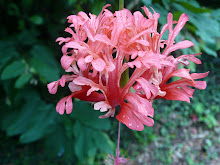
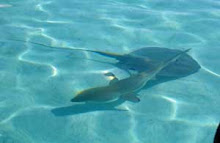
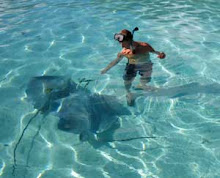
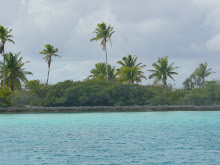
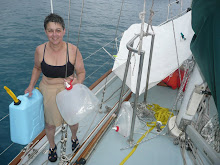
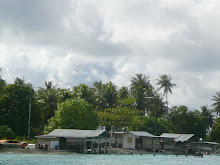

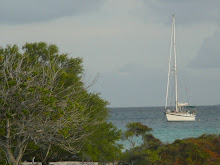
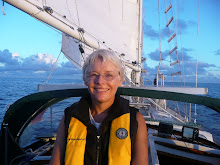
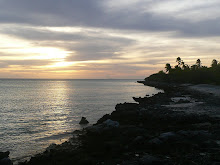

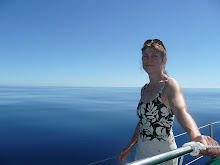


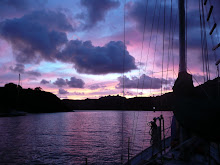

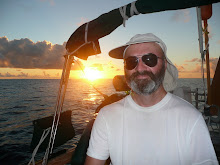
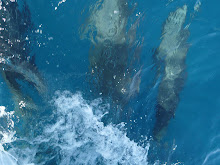
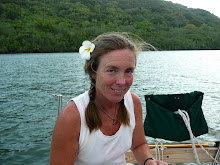
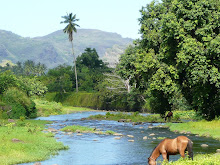
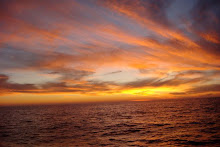


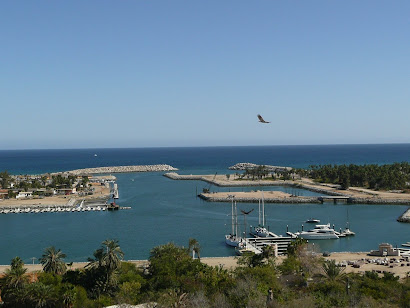




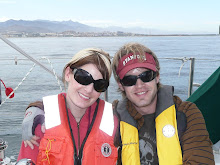

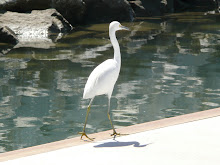

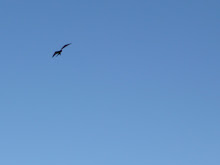
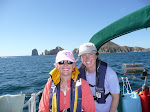

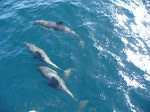



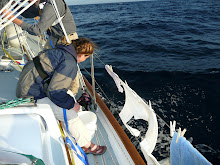







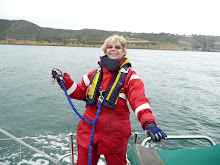

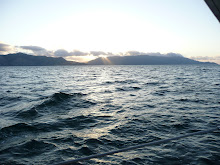



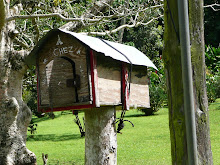
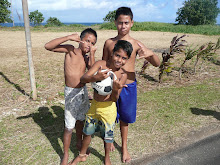




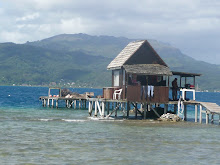

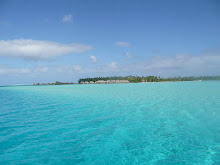


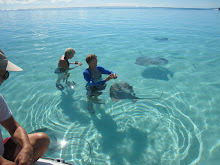
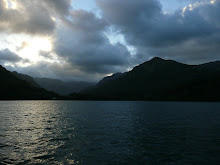



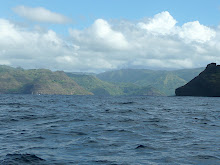
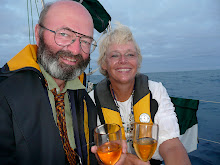
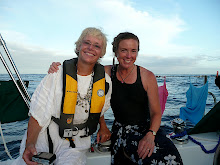


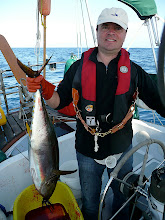

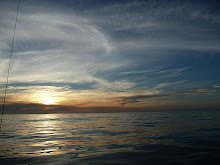

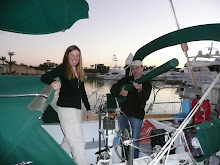
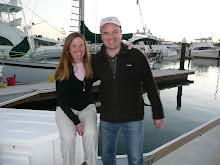
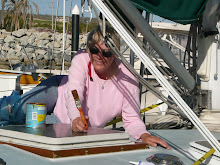
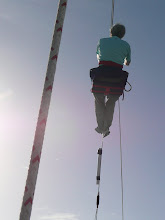

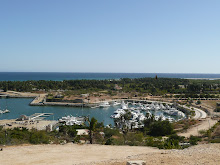
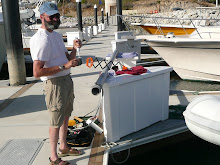


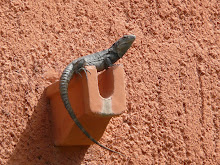
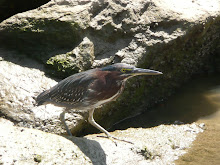
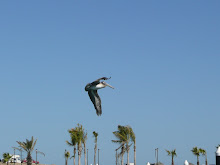

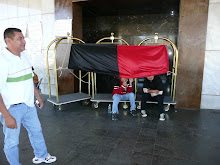
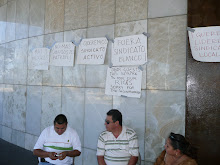
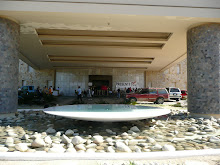
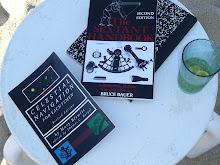
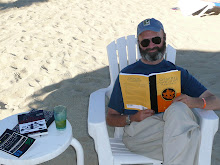
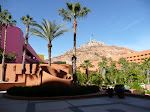





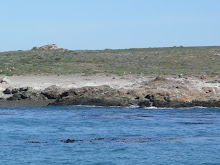
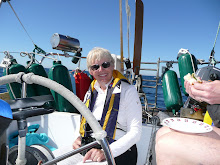

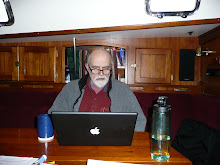


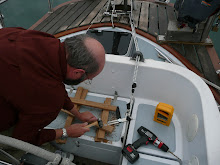

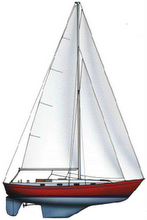
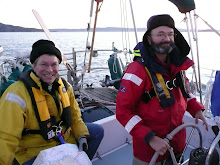
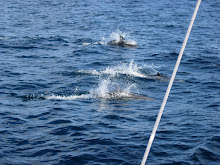




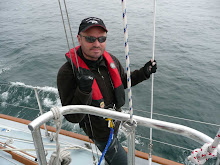
2 comments:
Oh. My. Gosh. What a storm, and what a blessing Pax made it through without a scratch!
Great to hear that you and Pax are safe! The boat will earn its name throughout your journey! Lots of rain in Seattle. FAns are pumped for Saturday Seahawk playoff game in Greenbay. Sail on!
Post a Comment